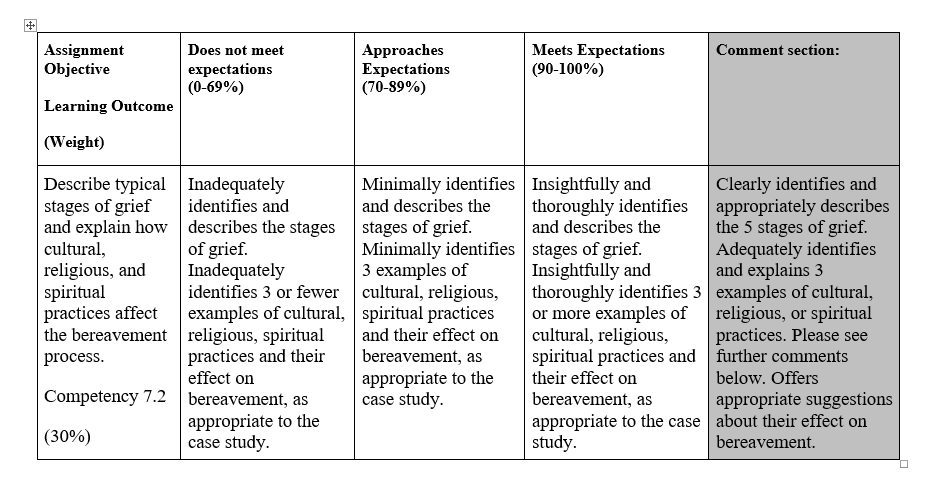Using Rubrics to provide Strength-based Feedback for Social Work Assignments

Editor’s Note: I am excited to welcome back Kristen Samuels, MSW, MS, MEd, the Field Director for University of Phoenix’s Department of Social Work, for this month’s guest educator blog post. Back in December 2018, I sent a tweet asking for advice on how to improve my grading practices, and turned the responses from colleagues into a blog post. Kristen was one of those colleagues and I asked her to turn her own tweets about strength-based feedback and rubrics into this blog post. Kristen can be reached at Kristen.samuels@gmail.com, or @KristenMSamuels on Twitter.
I recently returned to the classroom as a student in an EdD program. Although I certainly struggle with the workload, committing to life-long learning and taking the role of the student has made me a better instructor. As I am reminded of the anxiety that comes with unclear expectations or inconsistent grading practices, I become more aware of my own approaches for delivering feedback in my online classrooms. In discussions with my peers about the rigor and intensity of the doctoral writing process, we reflected on our individual fears in presenting written assignments to any of our former professors. Writing is an incredibly complex and emotive process. Students are asked to read, comprehend, apply, analyze, summarize, etc., and then present content in an integrated, accurate, and convincing way. It would be easy to miss a step and lose confidence in our position, and in that way, students are vulnerable when turning in written assignments. After putting forward long thought-out interpretations and opinions of the material, it is difficult to not view feedback as a personal attack on our intelligence. We wind ourselves up in self-doubt, and add undue stress when we throw in the impossible task of deciphering tone from an instructor’s feedback.
Strength-based feedback for Social Work Assignments
For this reason, and particularly for us as Social Work educators, we owe it to our students to present feedback with care. This can be as simple as avoiding capitalizing words (the online equivalent of shouting), and intentionally leading/ending feedback with what the student has done well in the assignment. Research on feedback tells us that affirmative comments acknowledges students’ efforts and encourages learning, instead of emphasizing grades (Stipek & Chiatovich, 2017). It is also an excellent way to model strengths-based approaches with our students!
This does not ignore our responsibility to offer corrective feedback, but in a way that promotes growth and ensures comprehension of the course objectives. Providing specific comments in areas where points were lost, can signal need for additional review and points of focus for future submissions. As supported by Gallien & Oomen-Early (2008), our responses should be an even mix of acknowledging their strengths and noted growth, as well as include strategies to promote reflection and deeper learning. The major dilemma for any social work educator is how to give thorough and timely individualized feedback, which is critical to student success and helps maintain academic standards long term, while managing the process of grading including the amount of time and energy needed.
For example, written assignments take a significant amount of time to thoroughly read and provide substantive feedback on. If the course objectives are best met through this means of assessment, your time will be well spent if you develop a rubric at the same time as the assignment. The audience of this blog is likely familiar with the term “rubric”, but you may want to consider the phrase “grading guide” with your students.
I prefer to provide written feedback to my student’s as opposed to verbal feedback by recording my reactions. My reason for this is accessibility. Although we assume that our students are connected with the services and tools that they need to be successful for our online courses, not all students self-report their needs, and I do not want them to miss out on this critical piece of learning. If the tool is embedded in your learning management system (LMS) such as Voicethread, it likely meets your institutions accessibility standards and is a fine alternative.
How I develop a rubric
As an instructor, I begin by developing an assignment in alignment with the course objective(s), and simultaneously develop the rubric. The objective(s) to be assessed in your assignment should be directly reflected in the assignment instructions, and then mirrored in the rubric. For example, if your objective is to “Describe typical stages of grief and explain how cultural, religious, and spiritual practices affect the bereavement process”, the assignment should expand on your expectations, and a line of your rubric should reflect measurement of those goals. For example:
Course objective to be assessed in this assignment: “Describe typical stages of grief and explain how cultural, religious, and spiritual practices affect the bereavement process.”
(Relevant portion of) Assignment instructions: Briefly describe each of the stages of grief from the text. Identify at least 3 examples of cultural, religious, or spiritual practices from the case study provided. How might this affect the clients’ bereavement process?
(Relevant portion of) Assignment Rubric:

Final comments: “Well done, Alex! You’ve earned XX out of XX points for this assignment. You’ve done well identifying and explaining the 5 stages of grief, and 3 examples of cultural practices that influenced the client’s bereavement. Your interpretation of the client’s spiritual ritual was fascinating, I hope you’ll share this perspective with the class in our discussion forum! I would add to your “bargaining” stage that this serves an important role for the client, where they temporarily escape from their pain and take time to process their new reality. In this stage the clients’ emotional needs are high, so it is important to review their support system of family and friends. I am seeing marked improvement in your writing style and APA, thank you for your hard work! This attention to detail will pay off not only in the course, but long term in your documentation skills in practice. Remember that a “Writing Guide” is posted in our course homepage with additional support including samples, resources, and best practices in formal writing. Overall, well done this week, Alex, I’m looking forward to seeing your work in Week 3. Please let me know if there is anything I can do to assist you before then!”
This final comments script can be easily altered for each student, keeping the basic framework and editing individual details. I prefer to use the indicators above – “Does not meet expectations”, “Approaches Expectations”, and “Meets Expectations” in my rubrics. I do not believe that “exceeding expectations” is fair to grade upon, but instead belongs in specific comments of praise and acknowledgement in the final feedback section. Generally, I develop my rubrics as follows:
- 70% content – listing each specific requirement to be addressed, as outlined in course/assignment objectives. Examples may include: Relevant content or analysis is accurately described and supported by research. Use of theory, examples, or other language are correct, comprehensive, and persuasive.
- 15% Organization and Structure – Effectively organized: introduction to provide background and preview points, body with logical transitions and appropriate tone, and conclusion reviewing major ideas.
- 15% Mechanics and APA – rules of grammar, spelling, usage, etc. are followed, intellectual property is appropriately cited consistent with APA formatting guidelines.
Designing detailed rubrics up-front saves time during the grading process. Making these available to the students along with assignment instructions clearly informs them of your expectations, provides them with an outline to organize their research, and helps minimize concerns of subjectivity in your grading process. It also speeds up the process for us as faculty, as you have already articulated what quality looks like in the final product, you simply need to provide detail on how they hit or fell short of these targets.
How do you use rubrics with your assignments? Please post your comments and ideas below.
References:
Gallien, T., & Oomen-Early, J. (2008). Personalized versus collective instructor feedback in the online courseroom: Does type of feedback affect student satisfaction, academic performance and perceived connectedness with the instructor? International Journal on ELearning, 7(3), 463-476. Retrieved from https://search-proquest-com.contentproxy.phoenix.edu/docview/210354848?accountid=134061
Stipek, D., & Chiatovich, T. (2017). The effect of instructional quality on low- and high-performing students. Psychology in the Schools, 54(8), 773–791. https://doi-org.contentproxy.phoenix.edu/10.1002/pits.22034
How to cite this blog post:
Samuels, K. (2019, February 4). Using Rubrics to provide Strength-based Feedback for Social Work Assignments [Blog Post]. Retrieved from:
https://laureliversonhitchcock.org/2019/02/04/using-rubrics-to-provide-strength-based-feedback-for-social-work-assignments/


